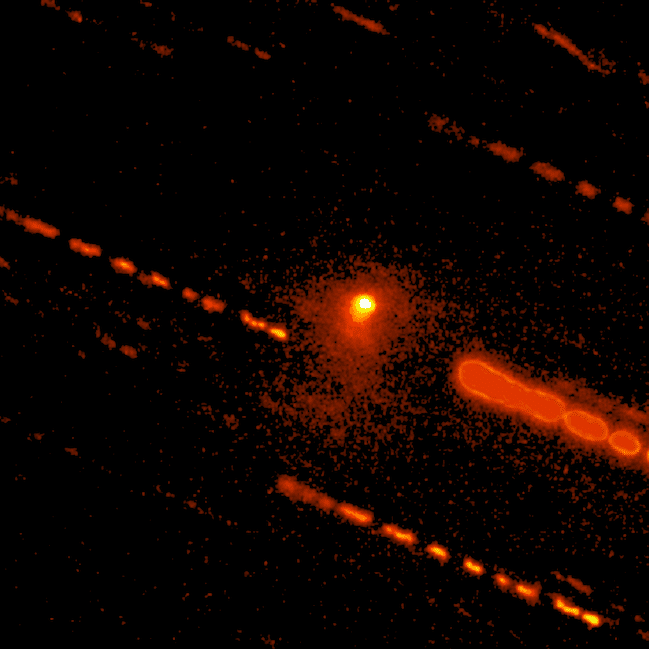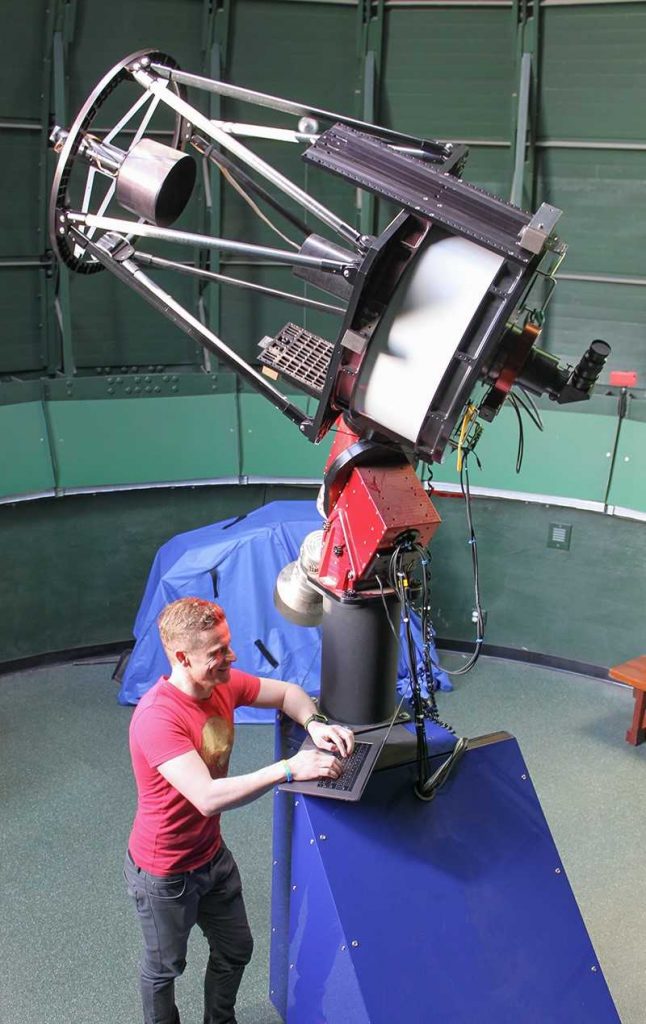From Northern Arizona University
Oct 28, 2020
Kerry Bennett
A team of astronomers, led by doctoral student and Presidential Fellow Colin Chandler in Northern Arizona University’s Astronomy and Planetary Science PhD program, earlier this year announced their discovery of activity emanating from Centaur 2014 OG392, a planetary object first found in 2014. They published their findings in a paper in The Astrophysical Journal Letters, Cometary Activity Discovered on a Distant Centaur: A Nonaqueous Sublimation Mechanism. Chandler is the lead author, working with four NAU co-authors: graduate student Jay Kueny, associate professor Chad Trujillo, professor David Trilling and Ph.D. student William Oldroyd.
“We detected a coma as far as 400,000 km from 2014 OG392 and our analysis of sublimation processes and dynamical lifetime suggest carbon dioxide and/or ammonia are the most likely candidates for causing activity on this and other active Centaurs. We developed a novel technique that combines observational measurements, for example, color and dust mass, with modeling efforts to estimate such characteristics as the object’s volatile sublimation and orbital dynamics.”
The team’s research involved developing a database search algorithm to locate archival images of the Centaur as well as a follow-up observational campaign.
“Our paper reports the discovery of activity emanating from Centaur 2014 OG392, based on archival images we uncovered, plus our own new observational evidence acquired with the Dark Energy Camera at the Inter-American Observatory in Cerro Tololo, Chile, the Walter Baade Telescope at the Las Campanas Observatory in Chile and the Large Monolithic Imager at Lowell Observatory’s Discovery Channel Telescope in Happy Jack, Arizona,” Chandler said.
As a result of the team’s discovery, the Centaur has recently been reclassified as a comet, and will be known as “C/2014 OG392 (PANSTARRS).”
“I’m very excited that the Minor Planet Center awarded a new comet designation befitting the activity we discovered on this unusual object,” he said.
This week, Chandler has been invited to present the results at the 52nd Division for Planetary Sciences (DPS) of the American Astronomical Society (AAS) 2020 meeting.
Centaurs are minor planets believed to have originated in the Kuiper Belt in the outer solar system.

They sometimes have comet-like features such as tails and comae—clouds of dust particles and gas—even though they orbit in a region between Jupiter and Neptune where it is too cold for water to readily sublimate, or transition, directly from a solid to a gas.
Only 18 active Centaurs have been discovered since 1927, and much about them is still poorly understood. Discovering activity on Centaurs is also observationally challenging because they are faint, telescope time-intensive and because they are rare.

This new image of C/2014 OG392 (PANSTARRS) and its extensive coma combines many digital images into a single 7,700 second exposure. The dashed lines are star trails caused by the long exposure. Images captured October 14, 2020 using the Large Monolithic Imager on the 4.3 m Lowell Discovery Telescope.





Doctoral student Colin Chandler works at NAU’s Barry Lutz telescope.


Chandler’s research is funded by Grant No. 2018258765 through the National Science Foundation’s Graduate Research Fellowship Program (GRFP), a highly competitive opportunity that only about 2,000 students receive each year.
See the full article here.
five-ways-keep-your-child-safe-school-shootings
Please help promote STEM in your local schools.
Northern Arizona University (NAU) is a public research university with its main campus in Flagstaff, Arizona. Governed by the Arizona Board of Regents and accredited by the Higher Learning Commission, the university offers 158 baccalaureate and graduate degree programs. It is classified among “R2: Doctoral Universities – High research activity”.
As of fall 2020, 29,569 students were enrolled, 21,495 at the Flagstaff campus. The average cost of tuition and fees for a full-time, Arizona resident undergraduate student for two semesters was $11,896 in 2020, and out-of-state undergraduates paid an estimated $26,642. NAU also participates in the Western Undergraduate Exchange Program, which offers lower tuition rates for students from the Western United States. For 2020–21, WUE tuition and fees are $17,221. NAU offers Flagstaff undergraduate students the Pledge Program, which guarantees the same tuition rate for four years.


